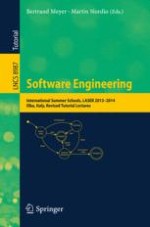2015 | Buch
Software Engineering
International Summer Schools, LASER 2013-2014, Elba, Italy, Revised Tutorial Lectures
herausgegeben von: Bertrand Meyer, Martin Nordio
Verlag: Springer International Publishing
Buchreihe : Lecture Notes in Computer Science
